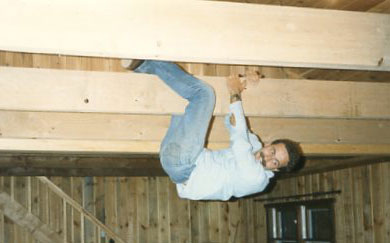 For the gazillionth time, we’re renovating. It’s like a sport for us…one that’s yet to be fully mastered.
For the gazillionth time, we’re renovating. It’s like a sport for us…one that’s yet to be fully mastered.
This time the kitchen is ripped apart. The windows over the sink rotted. Mosquitoes have begun to congregate around gaping peepholes eyeing their prey -- us. I'm sure I know what they're buzzing about -- my dated cabinets and countertops.
The living room has been in a constant state of redo. Currently, it is striped with paint samples just waiting for Ben Moore to prance in on his off-white horse with his eco-supreme Aura. He’ll just point his magic fan-thingy at the not-too-white wall colors and pick one that won’t send us into a toxic stupor.
 Why can't I decide which color? I'm too busy swooning over the luscious names on the cute sample cans of color goodness - Baby Fawn, White Dove, Sea Pearl, Lambskin, French Canvas, Nirvana...Sigh.
Why can't I decide which color? I'm too busy swooning over the luscious names on the cute sample cans of color goodness - Baby Fawn, White Dove, Sea Pearl, Lambskin, French Canvas, Nirvana...Sigh.
This is not the first time I’ve pondered the power of paint, but this is the first time I'm stymied by all the choices. I may decide which paint color solely because I'm feeling the name. Hands down, it will be Nirvana.
We’ve renovated this house so many times its already won trophies for skinless facelifts. But, the wins have been few and far between since all renovations were put on hold when the kids went to college. How could we pay tuitions and feed a revamping addiction? When the kids packed their bags - lock stock and skateboard, I seriously considered moving. Maybe I secretly wanted to adopt a clean slate to take the place of the kids?
Anyway, that's old news, and moving was not an option. We are invested in our not too big house in the woods. Not just in the money-pit kind of way, but in a way that says we’re going to get this house whipped into shape if it’s the last thing we do.
With the kids out of college, renovation bets are off. We’ve kicked into high gear again - our sights fixed on the prize. Only this time we have no choice – the kitchen windows are falling off the house.
3 discoveries about the latest renovation…
1. I used to love combing the books and shelter mags discovering the perfect mix of style and sustainability.
2. He used to love strapping on his toolbelt to slay home improvement projects that most of my friends thought only super contractors could do.
3. We’re tired.
He tells me these projects are killing his back. I can tell, he still loves the challenge, but he’s thinking maybe some young stud could come in and bang away at the mess. It might even save on prolotherapy bills (look it up, it seems to work for him). I don’t feel like spending the time it takes to find exactly what it is I want. Yet, I won’t be happy with anything less.
 I’m pining for that decorator who told me my house had "good bones" (yes, that's me and interior designer, Jayne Christie - thank you, Danny).
I’m pining for that decorator who told me my house had "good bones" (yes, that's me and interior designer, Jayne Christie - thank you, Danny).
Since we’re still paying many of those college loans off, the decorator idea is a pipe dream. So, I’ve unearthed the ‘ol tried and true renovation books in hopes that one will tell me that it is ok to just expand and replace the kitchen windows and close my eyes to all the other sagging and dated details crying out for attention.
Did I mention the cabinets are in pretty bad shape and the countertops are ugly?
We could replace the 30-yr old kitchen cabinets with slick glass doors, or totally ditch the cabinets - a look I absolutely love, but where’s the stuff stashed? Oh, one book says the cabinets can be painted. Hmm, then I could spend the savings on the countertops.
Tell me…has anyone ever painted solid wood cabinets and made them actually look good?
When we bought this house 26 years ago, we loved the kitchen. But, I seem to remember we solemnly pledged on our infant daughter to dump the counters as soon as we had enough dough. We soon found the kitchen was functional, and…really, at the time, the most important items in the kitchen were child-safety locks that didn’t pinch fingers.
A lifetime later, the kitchen hosts a professional stove, a slick bottom freezer/fridge, a slew of restaurant quality pots and pans (he would go for nothing less), and enough wine and wine glasses to inebriate a village.
The countertops?
Life got in the way. The counters got put on the back burner. And now that the windows are in disintegration-mode, the counters are rearing their ugly heads.
Last month, at the US Open of Renovation, I swear I read a ruling stating:
“New cabinets and counters can be grandfathered in with new windows – especially if you have important company coming over soon.”
 No, Serena, he says. You can not make up rules. The rulebook clearly says:
No, Serena, he says. You can not make up rules. The rulebook clearly says:
“Do not spend beyond our means.”
Oh, pleeeze. This is not a spectator sport.
I’m changing that rule.
Credits: dog - Jen Kiaba, cartoon - Danny Shanahan











